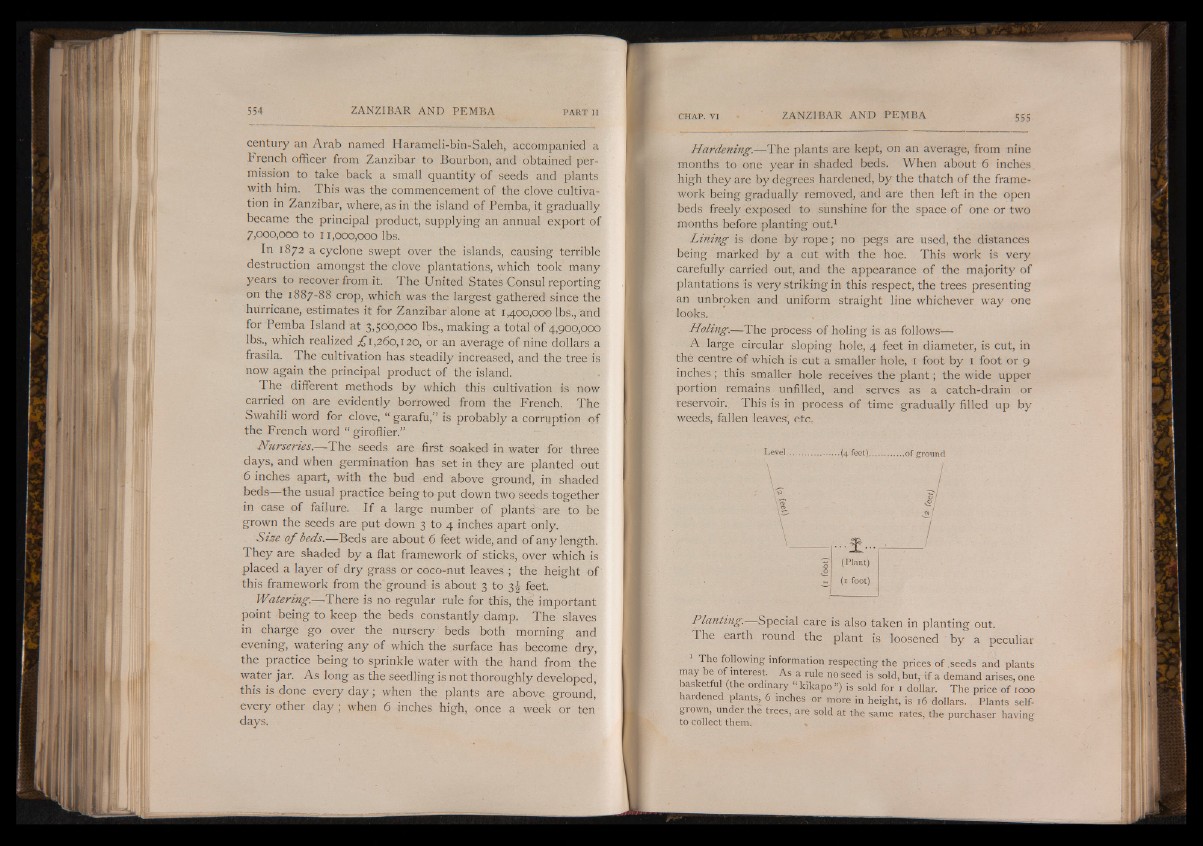
century an Arab named Harameli-bin-Saleh, accompanied a
French officer from Zanzibar to Bourbon, and obtained permission
to take back a small quantity of seeds and plants
with him. This was the commencement of the clove cultivation
in Zanzibar, where, as in' the island of Pemba, it gradually
became the principal product, supplying an annual export of
7,000,000 to 11,000,000 lbs.
In 1872 a cyclone swept over the islands, causing terrible
destruction amongst the clove plantations, which took many
years to recover from it. The United States Consul reporting
on the 1887-88 crop, which was the largest gathered since the
hurricane, estimates it for Zanzibar alone at 1,400,000 lbs., and
for Pemba Island at 3,500,000 lbs., making a total of 4,goo,000
lbs., which realized .£1,260,120, or an average of nine dollars a
frasila. The cultivation has steadily increased, and the tree is
now again the principal product of the island.
The different methods by which this cultivation is now
carried on are evidently borrowed from the French. The
Swahili word for clove, “ garafu,” is probably a corruption of
the French word “ giroflier.”
Nurseries.— The seeds are first soaked in water for three
days, and when germination has set in they are planted out
6 inches apart, with the bud end above ground, in shaded
beds— the usual practice being to put down two seeds together
in case of failure. If a large number of plants are to be
grown the seeds are put down 3 to 4 inches apart only.
Size o f beds.— Beds are about 6 feet wide, and of any length.
They are shaded by a flat framework of sticks, over which is
placed a layer of dry grass or coco-nut leaves ; the height of
this framework from the ground is about 3 to 3^- feet.
Watering.— There is no regular rule for this, the important
point being to keep the beds constantly damp. The slaves
in charge go over the nursery beds both morning and
evening, watering any of which the surface has become dry,
the practice being to sprinkle water with the. hand from the
water jar. As long as the seedling is not thoroughly developed,
this is done every d a y ; when the plants are above ground,
every other d a y ; when 6 inches high, once a week or ten
days.
Hardening.— The plants are kept, on an average, from nine
months to one year in shaded beds. When about 6 inches
high they are by degrees hardened, by the thatch of the framework
being gradually removed, and are then left in the open
beds freely exposed to sunshine for the space of one or two
months before planting out.1
Lining is done by rope; no pegs are used, the distances
being marked by a cut with the hoe. This work is very
carefully carried out, and the appearance of the majority of
plantations is very striking in this respect, the trees presenting
an unbroken and uniform straight line whichever way one
looks.
Holing.— The process of holing is as follows—
A large circular sloping hole, 4 feet in diameter, is cut, in
the centre of which is cut a smaller hole, 1 foot by 1 foot or 9
inches; this smaller hole receives the plant; the wide upper
portion remains unfilled, and serves as a catch-drain or
reservoir. This is in process of time gradually filled up by
weeds, fallen leaves, etc.
Level........................(4 feet),..:.......... of ground
(Plant)
(1 foot)
Planting. Special care is also taken in planting out.
The earth round the plant is loosened by a peculiar
The following information respecting the prices of .seeds and plants
may be of interest. As a rule no seed is sold, but, if a demand arises, one
basketful (the ordinary “ kikapo g is sold for 1 dollar. The price of 1000
ardened plants^ 6 inches or more in height, is 16 dollars. Plants selfgrown,
under the trees, are sold at the same rates, the purchaser having
to collect them.